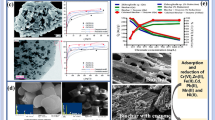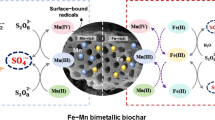Abstract
Due to the low iron solubility in alkaline soils, plants have evolved different iron acquisition strategies, which are either based on ferric iron reduction (strategy I) or complexation by phytosiderophores (strategy II). Recently, a prominent role of coumarins for iron acquisition has been discovered, but details of the respective mechanism remain unclear. Since coumarins may act as iron-binding ligands but also as reductants, various reaction sequences are possible, resulting in different iron species and oxidized coumarins. In this context, it is often overlooked that oxidized coumarins are not just byproducts of iron(III) reduction, but may be actively involved in further steps of iron mobilization. In order to verify this active role of oxidized coumarins in Fe(hydr)oxide dissolution, we complemented iron dissolution data with data of single coumarins (esculetin, scopoletin, fraxetin) and their oxidation products, as a function of time, pH, and mineral (goethite, lepidocrocite). Our results demonstrate that there are four different routes for coumarin oxidation, leading to quinones, dimers, hydroxylated coumarins, demethylated coumarins, and combinations of these. The time-dependent species pattern differs with respect to mineral, pH, and coumarin molecule. Oxidized coumarins are often more reactive than the original coumarins, explaining unexpected iron mobilization by scopoletin, which is demethylated to esculetin. Also oxidative hydroxylation and dimerization increase the number of phenolic groups and yield new chelating properties. Several iron-species are identified for the three coumarins. Since oxidation reactions are initiated directly at mineral surfaces, they are often very effective—but this does not always result in more iron mobilization.





Similar content being viewed by others
Data availability
Raw data are available on request.
References
Bourgaud E, Hehn A, Larbat R, Doerper S, Gontier E, Kellner S, Matern U (2006) Biosynthesis of coumarins in plants: a major pathway still to be unravelled for cytochrome P450 enzymes. Phytochem Rev 5:293–308
Castaldi P, Garau G, Palma A, Deiana S (2012) Formation of biopolymers owing to the oxidation of esculetine by Cu(II) ions in a Ca-polygalacturonate network. J Inorg Biochem 108:30–35
Chen R, Pignatello JJ (1997) Role of quinone intermediates as electron shuttles in Fenton and photoassisted Fenton oxidations of organic compounds. Environ Sci Technol 31:2399–2406
Clemens S, Weber M (2016) The essential role of coumarin secretion for Fe acquistion from alkaline soil. Plant Signal Behav 11:e1114197
Colombo C, Palumbo G, He JZ, Pinton R, Cesco S (2014) Review on iron availability in soil: interaction of Fe minerals, plants, and microbes. J Soils Sediments 14:538–548
Enache TA, Oliveira-Brett AM (2011) Phenol and para-substituted phenols electrochemical oxidation pathways. J Electroanal Chem 655:9–16
Faber H, Vogel M, Karst U (2014) Electrochemistry/mass spectrometry as a tool in metabolism studies—a review. Anal Chim Acta 834:9–21
Fourcroy P, Siso-Terraza P, Sudre D, Saviron M, Reyt G, Gaymard F, Abadia A, Abadia J, Alvarez-Fernandez A, Briat JF (2014) Involvement of the ABCG37 transporter in secretion of scopoletin and derivatives by Arabidopsis roots in response to iron deficiency. New Phytol 201:155–167
Fullenkamp DE, Barrett DG, Miller DR, Kurutz JW, Messersmith PB (2014) pH-dependent cross-linking of catechols through oxidation via Fe3+ and potential implications for mussel adhesion. RSC Adv 4:25127–25134
Garau G, Mele E, Castaldi P, Lauro GP, Deiana S (2015) Role of polygalacturonic acid and the cooperative effect of caffeic and malic acids on the toxicity of Cu(II) towards triticale plants (x Triticosecale Wittm). Biol Fertil Soils 51:535–544
Hagel JM, Facchini PJ (2010) Biochemistry and occurrence of O-demethylation in plant metabolism. Front Physiol 1:14. https://doi.org/10.3389/fphys.2010.00014
He J, Yang X, Men B, Bi Z, Pu Y, Wang D (2014) Heterogeneous Fenton oxidation of catechol and 4-chlorocatechol catalyzed by nano-Fe3O4: role of the interface. Chem Eng J 258:433–441
Jeitner TM (2014) Optimized ferrozine-based assay for dissolved iron. Anal Biochem 454:36–37
Kancheva VD, Slavova-Kazakova AK, Angelova SE, Singh SK, Malhotra S, Singh BK, Saso L, Prasad AK, Parmar VS (2017) Protective effects of 4-methylcoumarins and related compounds as radical scavengers and chain-breaking antioxidants. Biochimie 140:133–145
Kandegedara A, Rorabacher DB (1999) Noncomplexing tertiary amines as “better” buffers covering the range of pH 3–11. Temperature dependence of their acid dissociation constants. Anal Chem 71:3140–3144
Kang K, Schenkeveld WDC, Biswakarma J, Borowski SC, Hug SJ, Hering JG, Kraemer SM (2019) Low Fe(II) concentrations catalyze the dissolution of various Fe(III) (hydr)oxide minerals in the presence of diverse ligands and over a broad pH range. Environ Sci Technol 53:98–107
Kobayashi T, Nishizawa NK (2012) Iron uptake, translocation and regulation in higher plants. Annu Rev Plant Biol 63:131–152
Liang C, Ju W, Pei S, Tang Y, Xiao Y (2017) Pharmacological activities and synthesis of esculetin and its derivatives: a mini-review. Molecules 22:387
Lin Q, Li Q, Batchelor-McAuley C, Compton RG (2015) Two-electron, two proton oxidation of catechol: kinetics and apparent catalysis. J Phys Chem C 119:1489–1495
Maier GP, Butler A (2017) Siderophores and mussel foot proteins: the role of catechol, cations, and metal coordination in surface adhesion. J Biol Inorg Chem 22:739–749
Maier GP, Bernt CM, Butler A (2018) Catechol oxidation: considerations in the design of wet adhesive materials. Biomater Sci 6:332–339
Marschner H, Römheld V, Kissel M (1986) Different strategies in higher plants in mobilization and uptake of iron. J Plant Nutr 9:695–713
Musso H (1963) Phenol oxidation reactions. Angew Chem Int Ed 2:723–735
Nishiyama A, Eto H, Iguchi M, Yamamura S (1983) Anodic oxidation of pyrones and coumarins. Chem Pharm Bull 31:2853–2858
Panias D, Taxiarchou M, Paspaliaris I, Kontopoulos A (1996) Mechanisms of dissolution of iron oxides in aqueous oxalic acid solutions. Hydrometallurgy 42:257–265
Pillar EA, Camm RC, Guzman MI (2014) Catechol oxidation by ozone and hydroxyl radicals at the air-water interface. Environ Sci Technol 48:14352–14360
Rajniak J, Giehl RFH, Chang E, Murgia I, von Wirén N, Sattely ES (2018) Biosynthesis of redox-active metabolites in response to iron deficiency in plants. Nat Chem Biol 14:442–450
Reichard P, Kraemer S, Frazier S, Kretzschmar R (2005) Goethite dissolution in the presence of phytosiderophores: rates, mechanisms and the synergistic effect of oxalate. Plant Soil 276:115–132
Reichard P, Kretzschmar R, Kraemer S (2007) Rate laws of steady-state and non-steady-state ligand-controlled dissolution of goethite. Colloids Surf A 306:22–28
Römheld V, Marschner H (1986) Evidence for a specific uptake system for iron phytosiderophores in roots of grasses. Plant Physiol 80:175–180
Rugova A, Puschenreiter M, Koellensperger G, Hann S (2017) Elucidating rhizosphere processes by mass spectrometry—a review. Anal Chim Acta 956:1–13
Schenkeveld WDC, Wang Z, Giammar DE, Kraemer SM (2016) Synergistic effects between biogenic ligands and a reductant in Fe acquisition from calcareous soil. Environ Sci Technol 50:6381–6388
Schenkeveld WDC, Kraemer SM (2018) Constraints to synergistic Fe mobilization from calcareous soil by a phytosiderophore and a reductant. Soil Syst 2:67
Schmid NB, Giehl RFH, Döll S, Mock HP, Strehmel N, Scheel D, Kong X, Hider RC, von Wirén N (2014) Feruloyl-CoA 6’-hydroxylase1-dependent coumarins mediate iron acquisition from alkaline substrates in Arabidopsis. Plant Physiol 164:160–172
Schmidt H, Günther C, Weber M, Spörlein C, Loscher S, Böttcher C, Schobert R, Clemens S (2014) Metabolome analysis of Arabidopsis thaliana roots identifies a key metabolic pathway for iron acquisition. PLoS ONE 9:e102444
Siso-Terraza P, Luis-Villarroya A, Fourcroy P, Briat JF, Abadia A, Gaymard F, Abadia J, Alvarez-Fernandez A (2016) Accumulation and secretion of coumarinolignans and other coumarins in Arabidopsis thaliana roots in response to iron deficiency at high pH. Front Plant Sci 7:1711
Song Y, Buettner GR (2010) Thermodynamic and kinetic considerations for the reaction of semiquinone radicals to form superoxide and hydrogen peroxide. Free Radic Biol Med 49:919–962
Torres S, Brown R, Szucs R, Hawkins JM, Zelesky T, Scrivens G, Pettman A, Taylor MR (2015) The application of electrochemistry to pharmaceutical stability testing—comparison with in silico prediction and chemical forced degradation approaches. J Pharm Biomed Anal 115:487–501
Viollier E, Inglett PW, Hunter K, Roychoudhury AN, van Cappellen P (2000) The ferrozine method revisited: Fe(II)/Fe(III) determination in natural waters. Appl Geochem 15:785–790
Walter M, Kraemer SM, Schenkeveld WDC (2017) The effect of pH, electrolytes and temperature on the rhizosphere geochemistry of phytosiderophores. Plant Soil 418:5–23
Wang ZM, Schenkeveld WDC, Kraemer SM, Giammar DE (2015) Synergistic effect of reductive and ligand-promoted dissolution of Goethite. Environ Sci Technol 49:7236–7244
Yu Q, Kandegedara A, Xu Y, Rorabacher DB (1997) Avoiding interferences from Good’s buffers: a contiguous series of noncomplexing tertiary amine buffers covering the entire range of p H3–11. Anal Biochem 253:50–56
Ziegler J, Schmidt S, Chutia R, Müller J, Böttcher C, Strehmel N, Scheel D, Abel S (2016) Non-targeted profiling of semi-polar metabolites in Arabidopsis root exudates uncovers a role for coumarin secretion and lignification during the local response to phosphate limitation. J Exp Bot 67:1421–2143
Acknowledgements
Funding by the DFG (Grant WE 2422/8-1), and financial support by the‚ Ministerium für Innovation, Wissenschaft und Forschung des Landes Nordrhein-Westfalen ‘and by the‚ Bundesministerium für Bildung und Forschung’ is greatfully acknowledged.
Funding
Deutsche Forschungsgemeinschaft. Ministerium für Innovation, Wissenschaft und Forschung des Landes Nordrhein-Westfalen. Bundesministerium für Bildung und Forschung.
Author information
Authors and Affiliations
Corresponding author
Ethics declarations
Conflict of interest
The authors declare that they have no conflict of interest.
Additional information
Publisher's Note
Springer Nature remains neutral with regard to jurisdictional claims in published maps and institutional affiliations.
Electronic supplementary material
Below is the link to the electronic supplementary material.
Rights and permissions
About this article
Cite this article
Baune, M., Kang, K., Schenkeveld, W.D.C. et al. Importance of oxidation products in coumarin-mediated Fe(hydr)oxide mineral dissolution. Biometals 33, 305–321 (2020). https://doi.org/10.1007/s10534-020-00248-y
Received:
Accepted:
Published:
Issue Date:
DOI: https://doi.org/10.1007/s10534-020-00248-y




